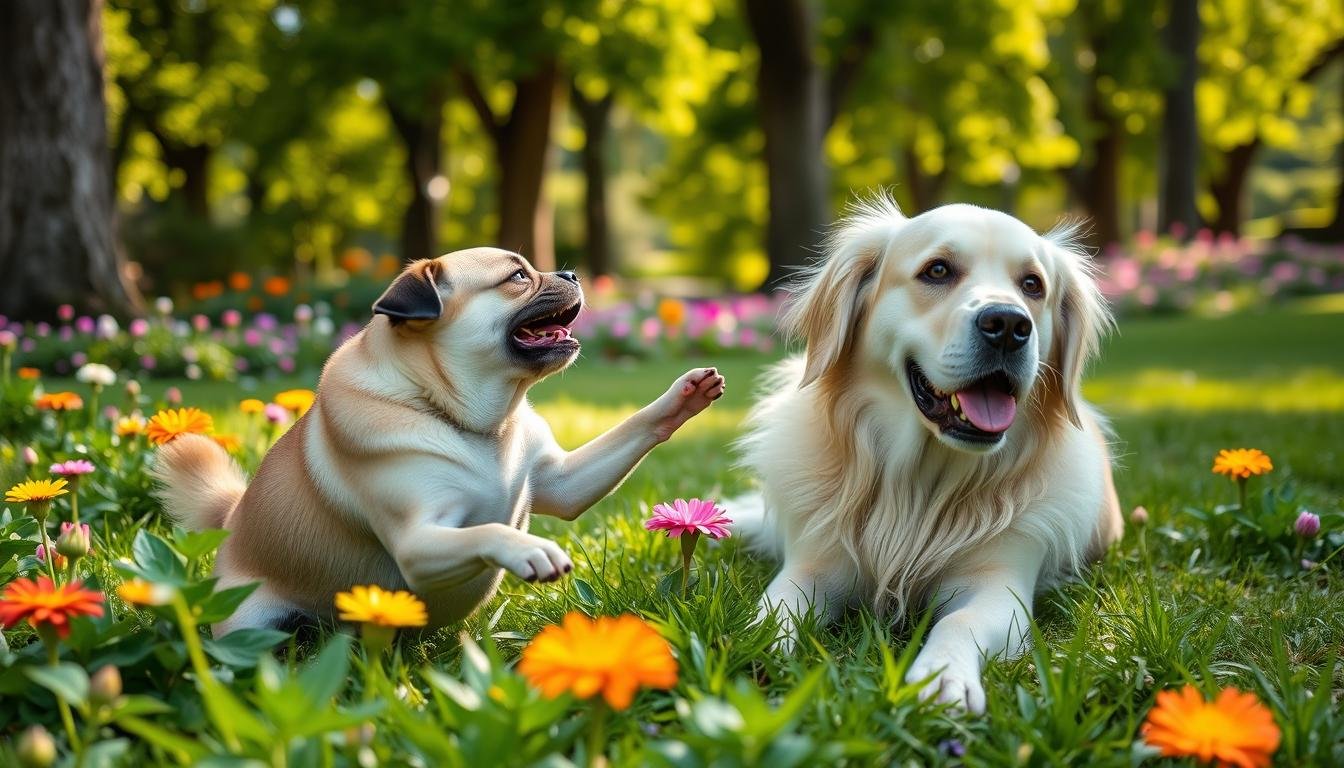How to avoid conflicts between Pugs and other dogs
Did you know that 96% of cases with interdog aggression treatment see an improvement? The median improvement rate is 69%. Still, managing conflicts between Pugs and other dogs can be tough. It’s important to understand the causes of aggression and take steps to prevent and address it.
As a Pug owner, knowing that up to 50% of aggressive dogs have separation anxiety is key. Also, 30% have phobias or generalized anxiety. Around 20% of aggressive dogs show aggression towards their owners. By tackling these issues, you can make your home a peaceful place for your Pug and other dogs.
Understanding Dog Aggression
Understanding dog aggression is key for pet owners. Dogs can show aggression in many ways, like mounting or blocking. This behavior can come from wanting to be in charge, defending their territory, or feeling scared or anxious.
Types of Aggression
Some dogs only get aggressive when their owners are around. They act fine when they’re alone. Hormonal changes or new pets in the house can also make dogs aggressive.
Common Triggers
A dog’s place in the pack can change over time. Not socializing them enough, past traumas, or anxiety can lead to aggression. Owners need to find out why their dog is aggressive and fix it.
“Aggression is reported as one of the main reasons why dog owners seek assistance from professional dog trainers or animal behaviorists.”
Knowing about dog aggression helps owners prevent and manage it. This way, they can keep their homes safe and happy for everyone.
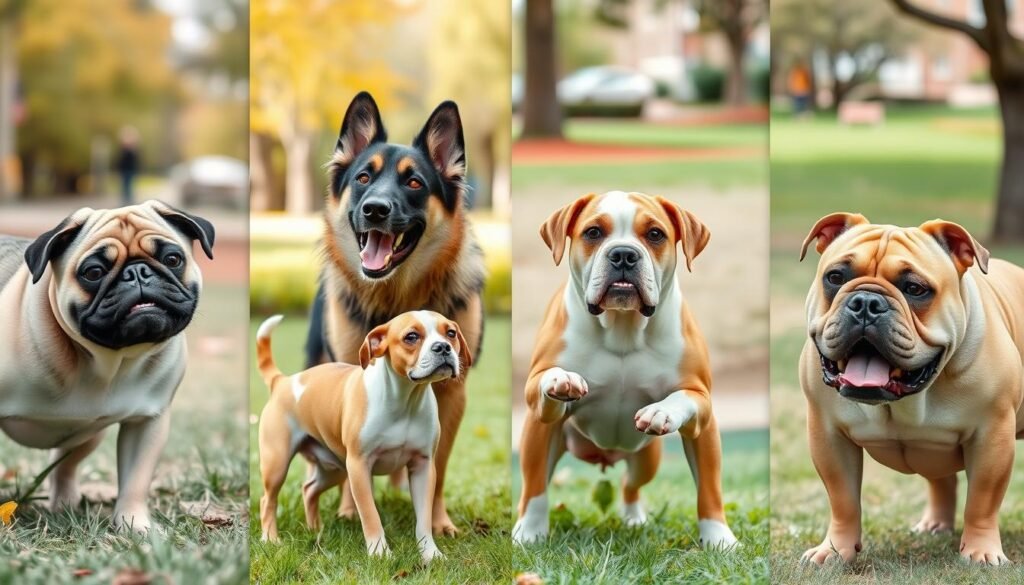
Establishing Owner Control
Getting full control as the owner is key to solving interdog aggression. Use verbal control, reward-based training, and a clear command-response program. These methods help stop attention-seeking and teach dogs to earn rewards from you, not themselves.
Verbal Control and Reward-Based Training
Teach your dogs to settle on command and follow important cues. Positive reinforcement like treats and praise is great for this. It shows them obeying your commands gets them rewards.
Command-Response Program
Start a command-response program where you control everything. Make sure they’re calm and respectful before giving rewards. This makes you the leader and stops aggression.
Make a daily plan with training, play, and rest. This meets their needs and lowers aggression chances.
Use leashes and head halters for separating dogs if needed. This keeps them safe and stops fights.
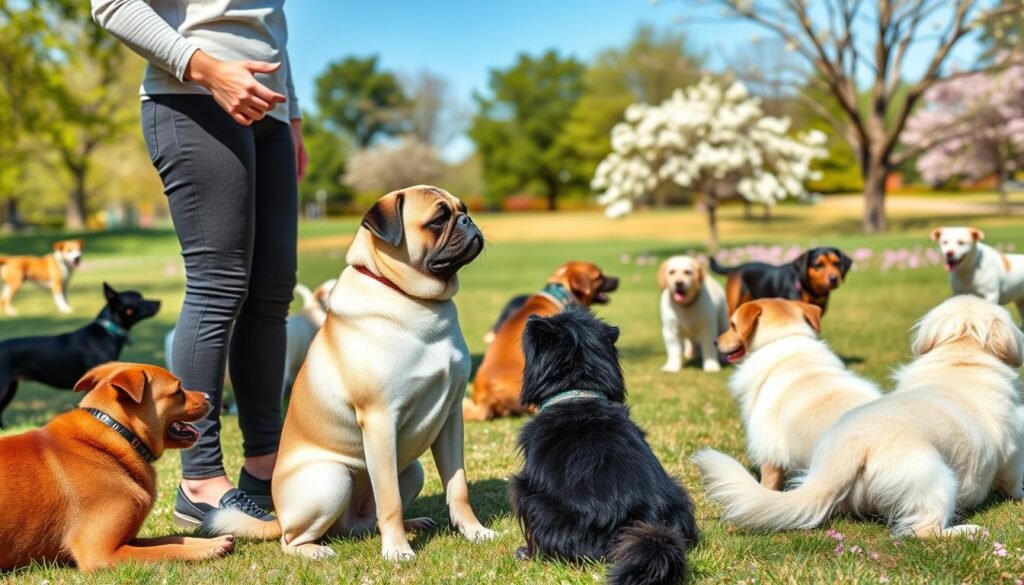
“The goal is to eliminate attention-seeking behaviors and teach the dogs that all rewards come from the owner on their terms, not the dog’s.”
Identifying and Avoiding Aggressive Situations
As an owner, it’s key to know what makes your Pug and other dogs fight. Things like food, toys, and attention can spark fights. Even excitement, like when they meet people or bark at others, can cause trouble.
To stop these fights, you must control your dogs and watch how they interact. Here are some tips:
- Keep your dogs away from things they might fight over. Give them their own food and places to rest. Watch them closely when they’re together.
- Don’t let your dogs get too excited too soon. Start with calm activities and slowly add more excitement while keeping them in line.
- Let your dogs meet other dogs in a safe place. This helps them learn how to act around others.
- If your dogs don’t like to share, use muzzles to keep them safe. The Dean & Tyler Freedom Muzzles and Baskerville Ultra Muzzles are good choices.
By knowing and avoiding what makes dogs fight, you can help them live together peacefully. Early training and socializing are very important. They help prevent fights in Puggles and other dogs.
“Avoiding situations that may excite or frustrate adolescent dogs can help in managing their behavior.”
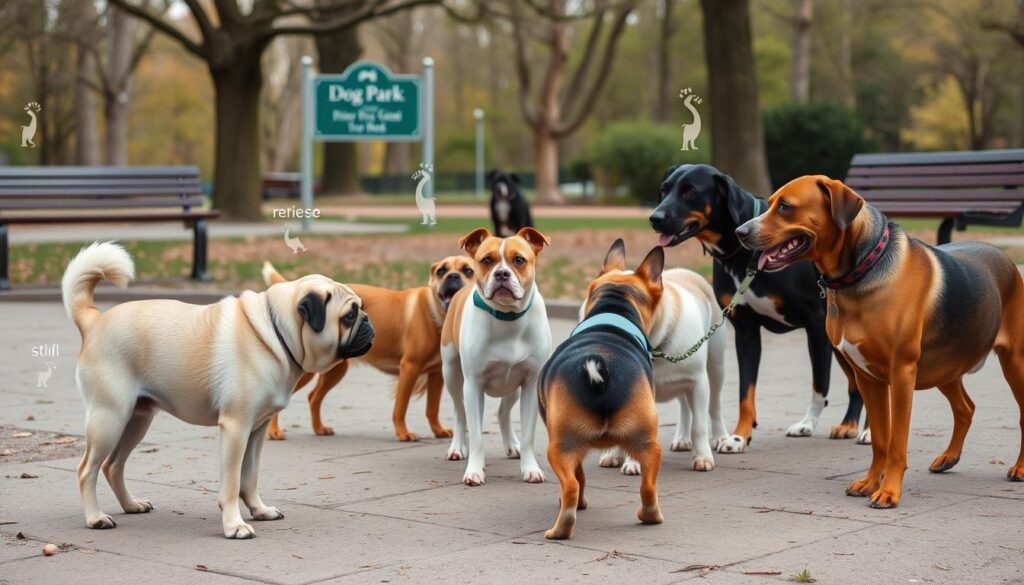
How to avoid conflicts between Pugs and other dogs
Getting Pugs and other dogs to get along can be tricky. Pugs, being small, often clash with bigger dogs. To keep peace, it’s vital to lead all dogs firmly and consistently.
Start a “nothing in life is free” program. This means your Pug must work for treats and attention. It makes you the leader and stops them from guarding things. Also, always favor your Pug to avoid fights over attention.
When introducing your Pug to other dogs, do it slowly and carefully. Use tricks like desensitization to make your Pug feel safe. Regular training and watching them closely helps keep everyone calm.
Medicine might help if your Pug gets anxious or aggressive. It can help manage their mood and behavior. This way, they’ll get along better with other dogs.
“The key to avoiding conflicts between Pugs and other dogs is establishing clear leadership, implementing proactive training, and creating a sense of security and belonging for your Pug within the household.”
Always put your dogs’ safety first. With time, effort, and the right methods, your Pug and other dogs can live together peacefully. This makes for a happy and healthy home.
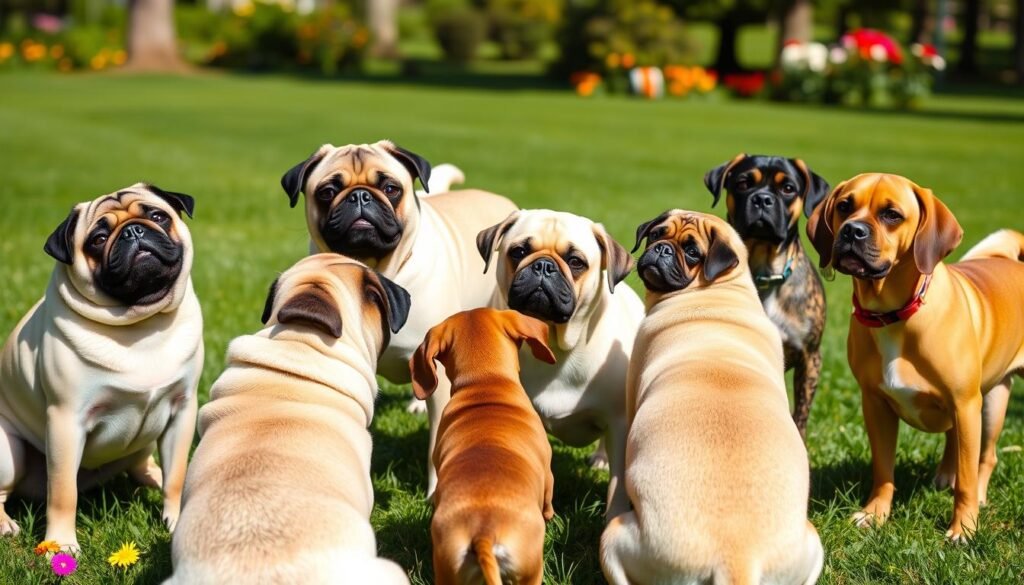
The “Nothing in Life is Free” Program
The “nothing in life is free” program helps you control your dog better. It teaches them to earn everything, like food and toys, by obeying you. This makes them calm and respectful around valuable things.
Earning Resources
This program is all about earning. Dogs must behave well, like sitting or coming when called, to get what they want. It shows you’re in charge and keeps them calm and obedient.
Independence Training
Independence training is also key. Dogs learn to be okay when they’re apart from each other and you. This reduces fights and aggression between them.
By following this program, you show your dogs who’s boss. With time, patience, and positive feedback, your dogs will be happy and well-behaved. They won’t fight or act aggressively.
“A well-trained dog is a happy, confident dog that knows its place in the pack and is content to follow your lead.”
Showing Preference to One Dog
Creating a clear order in your home is key to less fighting between your Pug and other dogs. Show one dog you prefer by giving them first choice of food, treats, and toys. Also, let them have your attention first.
Make sure the preferred dog gets the best stuff. This makes your home more structured and peaceful. It helps avoid fights and shows who’s in charge.
Using this method with the “Nothing in Life is Free” program teaches dogs who gets what first. The second dog must wait patiently. This way, you manage who gets what and keep peace in your home.
“Only a very small percentage of brachycephalic dogs receive corrective surgery for breathing difficulties.”
This isn’t about favoring one dog over the other. It’s about keeping things calm and orderly. By always choosing one dog, you help keep your home peaceful and avoid fights.
Desensitization and Counter-Conditioning
Dealing with aggression between dogs can be tough. But, there are effective ways to handle it. Desensitization and counter-conditioning are two key methods. They involve slowly introducing the dogs to each other in a controlled, positive way. This helps them learn to be calm and obedient.
Gradual Exposure
The gradual exposure process is vital. Owners should watch closely as dogs are introduced, using tools like head halters and muzzles if needed. Dogs are rewarded with treats, play, or attention for obeying commands. The handlers should be upbeat and positive, never punishing or scolding.
As dogs get more comfortable, the distance between them is gradually reduced. This should only happen if no aggression is shown. Walking them together on a leash can also help them bond and release energy positively.
Obedience Training and Rewards
Consistent, reward-based obedience training is crucial. It teaches dogs to follow commands and link the other dog’s presence with positive experiences. This helps manage their interactions and prevents aggressive behavior.
The success of desensitization and counter-conditioning depends on the dog’s positive association with the other dog. This takes time, but with patience and persistence, it can help dogs overcome aggression.
“The key to successful desensitization and counter-conditioning is keeping the dog below their emotional threshold, where they can remain calm and associate the trigger with positive experiences.”
Medication and Other Aids
Your vet might suggest medication for your dog’s aggressive behavior. Fluoxetine is often used. It’s an SSRI that can lessen aggression and anxiety. It may take 2-4 weeks to start working, and your vet might change the dose.
There are also anti-anxiety products that can help. Adaptil uses pheromones to calm dogs. Thundershirts apply gentle pressure to help reduce anxiety and aggression.
Medication is just one part of the solution. Regular exercise, obedience training, and spaying or neutering are also key. By using all these methods together, you can help your dog feel better and live a happier life.

